| De Rochemont Discovers Docudrama |
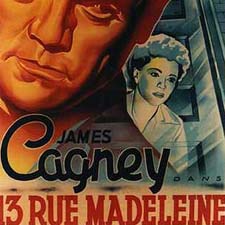
SEACOAST NH FILM
Did you know that maverick film producer Louis de Rochemont won two Academy Awards? After his lengthy success with March of Time, the Seacoast NH filmmaker merged documentaries with factual dramas. We call him the "Father of the Docu-drama". De Rochemont's films were "ripped from the headlines" long before the made-for-TV movie made this genre a hot property.
SEE: Louis de Rochemont FILMOGRAPHY
SEE: More Local Film Stories
It's not easy being the parent of a wayward child. The elders live in the wake of their infamous issue, consigned to the footnotes of history. And so it has been, undeservedly, for Seacoast film producer Louis de Rochemont, father of the "docu-drama". This risky mix of fact and theater has found a permanent hideout on television. I gave up television a few years ago, but in my day this outlaw film style offered us the "true story" of Charlie Manson, Pam Smart, Amy Fisher, Bill Gates, the raid at Waco, Lady Di, John Belushi and countless others.
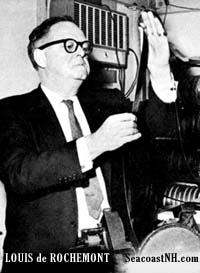 Long before all that, de Rochemont gave us "The House on 92nd Street" (1945), his seminal docu-drama of atomic spies and counter espionage. Like no one before him, de Rochemont ignored glitzy Hollywood sets and took his cameras deep inside the covert world of the Federal Bureau of Investigation. A documentary filmmaker by trade, de Rochemont wanted to tell real stories, starring real people in real locations. The result is a gritty classic that some critics still credit as the beginning of film noir, popular into the 50's and enjoying a revival in films today.
Long before all that, de Rochemont gave us "The House on 92nd Street" (1945), his seminal docu-drama of atomic spies and counter espionage. Like no one before him, de Rochemont ignored glitzy Hollywood sets and took his cameras deep inside the covert world of the Federal Bureau of Investigation. A documentary filmmaker by trade, de Rochemont wanted to tell real stories, starring real people in real locations. The result is a gritty classic that some critics still credit as the beginning of film noir, popular into the 50's and enjoying a revival in films today.
Certainly de Rochemont influenced the noir movement (from the French for "black" film) rooted in the dark richly-sleazy crime tales of Dashiell Hammett and Raymond Chandler. De Rochemont was caught up in the same fearsome War era, when the world waited to see who would become the next Evil Empire. But he did not wallow in the romance of it all, preferring the drama "ripped from the headlines" to fiction. His heroes were well-schooled ID-toting G-men, not moody alcoholic gumshoes. His style looks like film noir because film noir also drew its content from the dark crime tales that fed the city tabloids.
CONTINUE de Rochemont
(more) Father of the Modern Docu-Drama
Because he produced, rather than directed most of his films, de Rochemont floats invisibly in the background of an eclectic array of movies. No biography of him exists and his on-location style shooting and journalistic approach to characters leaves some viewers cold.
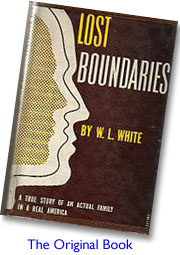 My introduction to the Newington, NH filmmaker (born in Chelsea, Mass in 1899) was through his locally-focused films, the ones that caused such excitement in the Seacoast years after World War II. "Lost Boundaries" (the story of a NH black family "passing" as white) and "Whistle at Eaton Falls" (about a wild-cat factory strike) are still spoken of around here with pride, even reverence.
My introduction to the Newington, NH filmmaker (born in Chelsea, Mass in 1899) was through his locally-focused films, the ones that caused such excitement in the Seacoast years after World War II. "Lost Boundaries" (the story of a NH black family "passing" as white) and "Whistle at Eaton Falls" (about a wild-cat factory strike) are still spoken of around here with pride, even reverence.
True to the de Rochemont formula, the plots of both films sprang from real incidents. By the time they were released in 1949 and 1951 de Rochemont was a maverick film-maker, at odds with the slick Hollywood machine. He was already legendary for his March of Time series, the world-wide news clips that appeared each week in theaters between the cartoon and the main feature. Kids in the audience groaned when the news section appeared, but they watched. Before the arrival of television, de Rochemont film shorts, like Walter Winchell on the radio and the Hearst newspapers, was a primary source of current events. If we agree that moving images are extremely powerful, through the 1930's and 40's de Rochemont was among the most influential men in America.
Then suddenly he wasn't. During WWII, de Rochemont had used his March of Time skills to produce patriotic documentaries: Ramparts We Watch (1940), We are the Marines (1942) and Fighting Lady (1944) which won an Academy Award. With the conflict over, the man who had filmed and interpreted presidents, kings and dictators in war, turned toward more narrative work in peace. There were so many great American stories to tell.
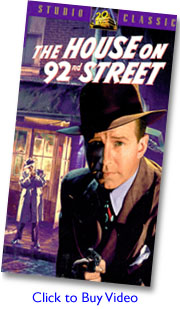 What could be more compelling than a peek inside the FBI building and a story ripped from their secret spy files? "The House on 92nd Street" opens with actual FBI surveillance film of employees coming and going from the German embassy in Washington. In his inimitable manner, de Rochemont insisted that real FBI agents play themselves, with only a small cast of professionals in lead roles. The melodramatic result is a deadpan Lloyd Nolan as FBI Agent Mr. Briggs, the progenitor of emotionless characters like Sergeant Friday (Jack Webb) in "Dragnet", Eliot Ness (Robert Stack) or Mr. Phelps (Peter Graves) in television's "Mission Impossible" and a whole host of modern crimestoppers.
What could be more compelling than a peek inside the FBI building and a story ripped from their secret spy files? "The House on 92nd Street" opens with actual FBI surveillance film of employees coming and going from the German embassy in Washington. In his inimitable manner, de Rochemont insisted that real FBI agents play themselves, with only a small cast of professionals in lead roles. The melodramatic result is a deadpan Lloyd Nolan as FBI Agent Mr. Briggs, the progenitor of emotionless characters like Sergeant Friday (Jack Webb) in "Dragnet", Eliot Ness (Robert Stack) or Mr. Phelps (Peter Graves) in television's "Mission Impossible" and a whole host of modern crimestoppers.
Recently re-released on video by 20th Century Fox, de Rochemont's groundbreaking film was a slap of reality in the face of schmaltzy Hollywood romances. With the blessing of FBI chief J. Edgar Hoover, de Rochemont synthesized authentic bureau records to create a composite story. In this "true to life" adventure, the Nazi fifth column of American-based spies tries to steal the formula for Project 93 -- the secret of the atomic bomb. Using double agent William Dietrich (William Eythe), FBI inspector Mr. Briggs uncovers the plot and saves the free world.
CONTINUE de Rochemont
(more) Father of the Modern Docu-Drama
It's a gripping what-if-they-didn't-catch-him thriller and still a surprisingly good film. De Rochemont's award-winning story (written by Charles Booth) was exactly what post-War Americans wanted to hear. We are the good guys and the world is now a safe place because American spies are better than everyone else's spies. By the end of the war there were 15,000 people working for the FBI. With the war over, a new enemy was needed to keep everyone gainfully employed. When Richard Nixon later uncovered Communist spies under every pumpkin patch - we were off and running again. One man's truth, is another man's propaganda.
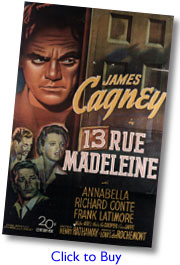 Long before James Bond, Louis de Rochemont produced two more counter spy thriller docu-dramas, also named after streets. Immediately following the success of "92nd Street" he hired top box office draw James Cagney to star as an OSS agent in "13 Rue Madeleine" (1946). I just ordered that one from Amazon.com. Using scenes shot in Boston and our Seacoast area, he released "Walk East on Beacon" (1952), also released as "Crime of the Century." That one isn't available on video, but I have the old comic book. "See the FBI crack down on spies!" the back cover announces. Real G-men solve crimes right before your eyes! Golly gee, kids!
Long before James Bond, Louis de Rochemont produced two more counter spy thriller docu-dramas, also named after streets. Immediately following the success of "92nd Street" he hired top box office draw James Cagney to star as an OSS agent in "13 Rue Madeleine" (1946). I just ordered that one from Amazon.com. Using scenes shot in Boston and our Seacoast area, he released "Walk East on Beacon" (1952), also released as "Crime of the Century." That one isn't available on video, but I have the old comic book. "See the FBI crack down on spies!" the back cover announces. Real G-men solve crimes right before your eyes! Golly gee, kids!
From here de Rochemont's career spiraled off into a roman candle array of projects, linked only by his interest in real-life documentary topics. He produced a biography on "Martin Luther" (1953), a wide-screen tour of America in "Cinerama Holiday" (1955) and the first British feature-length cartoon based, of all things, on George Orwell's "Animal Farm" (1955). Unpredictable to the end, before returning to educational documentaries, he filmed a tall ship tour from Norway to South American in "Windjammer" (1958) which included a scene shot in Portsmouth, NH and was directed by his son referred to as de Rochemont III. Louis' last major motion picture starred Vivian Leigh with a newcomer named Warren Beatty as a gigolo in Tennnessee Williams' "Roman Spring of Mrs. Stone" (1961). De Rochemont died here in 1978 with files brimful of rough scripts for stories he wanted to transform to film.
And what about his errant child, the docu-drama? It's all around us in reality-based re-enactments, made for TV movies and a flood of what has been dubbed "neo noir" films pouring from Hollywood and the independents. Dubious achievements like "Blair Witch" and "Pulp Fiction" are not de Rochemont's fault. His mission was always to educate, not to shock. He would have preferred loftier topics -- "Apollo 13" over "The True Story of the Three Stooges," while a Monica and Bill docu-drama would certainly have intrigued him. Although he appreciated composite characters, de Rochemont sneered at corpulent Hollywood budgets. He would have shot a film about the American Revolution on the very fields where it was fought. Usually he shot as close to his home in Newington, NH as possible. On his list of unfinished projects was a docu-drama about Portsmouth ale-tycoon Frank Jones and another about the 1873 ax murders on Smuttynose Island, an idea that eventually flopped as the film "weight of Water".
The itching question remains -- where does the truth live in a docum-drama? When American newscasters were reluctant to show the face of Adolph Hitler to nervous Americans in the 1930s, de Rochemont broke with etiquette and forced millions of theater-goers to confront the dictator onscreen in the flesh. Yet for all his insistence on reality, the producer had no moral problem inserting artificial footage into news clips when conditions demanded it. A study of "The March of Time" by author Raymond Fielding explains how de Rochemont hired impersonators to double as famous figures in scenes spliced into the weekly news footage. Residents of Newington tell tales of how their relatives and friends frequently found themselves depicted in March of Time when a missing shot was needed.
The truth that Louis de Rochemont chased around the world so many times, it seems, takes many forms. Facts, even documentary films, can lie or mislead, while sheer fantasy may convey the deepest truths. Louis, I'm guessing, would be happy to argue both points with gusto.
Copyright (c) J. Dennis Robinson / SeacoastNH.com First published June 2000. Revised 2005.
